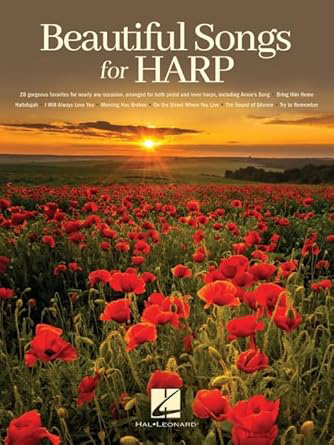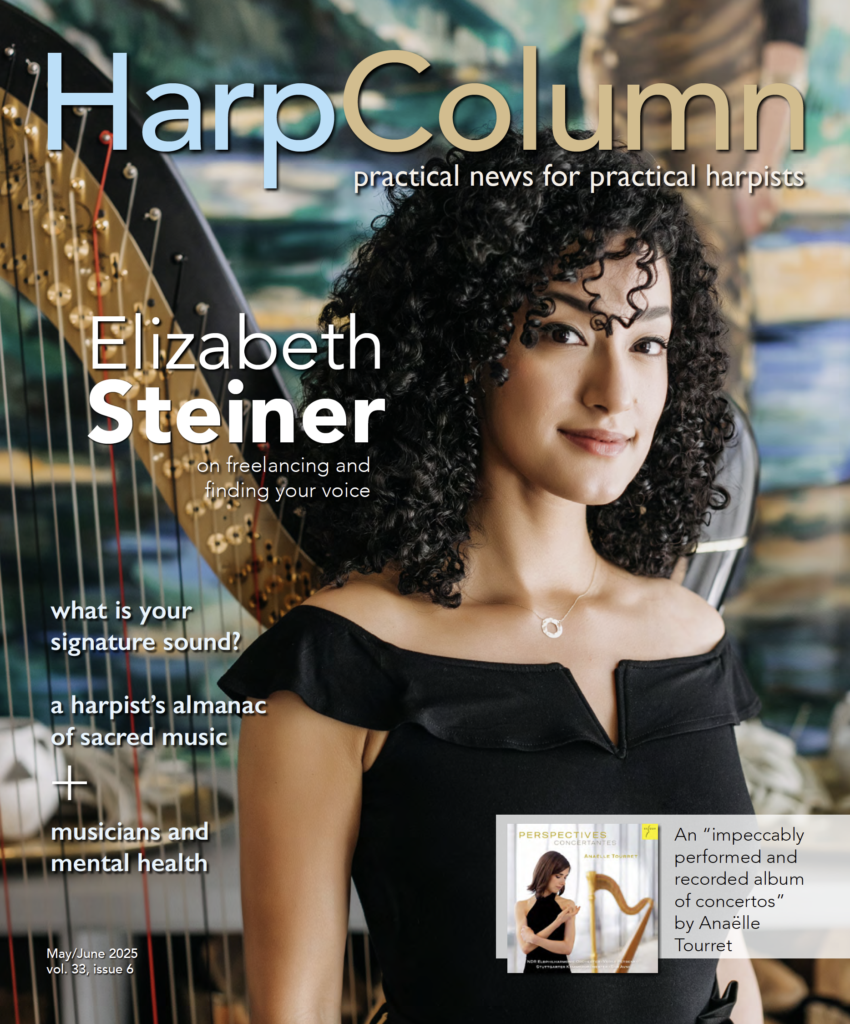


From l. to r.: Ann Lobotzke’s Beautiful Songs for Harp is a collection of 28 “pop music evergreens, suitable for a variety of occasions;” Cindy Horstman also published a “mellow” original tune titled “Remembering,” composed in memory of her father, and an “interesting” arrangement of “Scarborough Fair.”
Having four or more hours of popular music that is performance-ready at a moment’s notice is not an easy task. Not every piece has to be Concert Variations on Moon River, but music that is a one-note melody line in the right hand accompanied by an occasional triad in the left hand is the other extreme. Ick. What if improvising doesn’t fall in your comfort zone? Where do you find arrangements of pop standards that are sight-readable for the intermediate level, but don’t sound too elementary?
Look no further. Hal Leonard has published Beautiful Songs for Harp, a collection of 28 popular tunes arranged by Ann Lobotzke. These selections are suitable for a variety of occasions and are especially useful when providing background music for cocktail receptions or dinners. Lobotzke chose recognizable melodies spanning nine decades.
Each song is notated for both pedal and lever harp. Lever harps should be tuned to E-flat. Seven tunes don’t have any changes. These include “Annie’s Song,” “Bless the Broken Road,” “Chariots of Fire,” “Hallelujah,” “I Will Always Love You,” “My Own True Love,” and “The Sound of Silence.” The Beatles tune, “And I Love Her,” has one simple lever change at the very end.
There are a few errors. On page 68 of “On the Street Where You Live,” the F-sharp pedal marking at the end of the second line is a little too late—it needs to be moved two measures earlier. There are also some pedal and lever markings missing on page 48 of “If Ever I Would Leave You.” The middle C and 5th octave C levers need to be raised to sharp by the second measure of the third line (m. 42). Pedal harps need to move C to sharp at m. 42 as well. The middle C lever can be raised and lowered along with the 4th octave D lever changes already notated. The C pedal needs to return to natural on the second beat of the first measure of the bottom line (m. 45). This is a tricky section for lever harps!
Let’s look at the pluses and minuses overall. There are some special effects sprinkled in among the pieces and it’s always a nice touch to showcase the different timbres of the harp. For example, there are scale glisses (as in “Try to Remember”), harmonics (“Can’t Help Fallin’ in Love”), and p.d.l.t. (“Chariots of Fire”). Pedal markings are prominently written in the center of the staff where they won’t be missed. Diamond-shaped notes indicate lever changes.
Whenever possible, Lobotzke retained the original harmonies that we recall yet managed to keep pedal and lever changes to a minimum by omitting some of the notes in the chords. She also provided chord symbols so you can embellish if you choose. In several of the intros she used the familiar “hook” that lets the audience know what they’re about to hear (e.g., “Singin’ in the Rain,” or “The Rainbow Connection”). The preface includes some suggestions and explanations, and she encourages players to expand upon these relatively simple arrangements. Fingering is suggested where it is most helpful.
On the minus side, the diamond-shaped notes for lever changes are very tiny. Even if you highlight them, they are difficult for someone with poor eyesight to see. Using a larger font for symbols (if available in the music writing software used) would be helpful.
Measure numbers would also be helpful, and none are included. If lyrics were included in between the staves, younger harpists who might not be familiar with some of these older tunes would know where to bring out the melody. Alternatively, the music could be typeset with the stems down for the harmony and fill, and stems up on the melody, as is often the case with pop piano arrangements. Fortunately, you can listen to almost anything on YouTube to become familiar with a song—a luxury older harpists didn’t have. A solo instrumentalist must use dynamics to separate the melody from the fill, so it would help to know exactly where the melody is.
These suggestions aside, the pluses far outweigh the minuses on this very practical tome. If you need some pop music evergreens, this book should be in your library.
Another new publication in the pop genre is a very lovely original tune by Cindy Horstman. “Remembering” is a mellow, self-published pedal harp solo in memory of Horstman’s father. It is in E-flat with several easy pedal changes, all notated below the staff. The typesetting is easy to read and the two page turns are manageable. No fingering is provided and shouldn’t be necessary as the music is suitable for the intermediate or advanced level player.
There is a recurring motif in the right hand that you can hear for yourself on Horstman’s website, cindyhorstman.com. It is a little over four minutes in length. It’s a pretty melody that received the bronze medal in the Global Music Awards.
Horstman has also done an interesting solo arrangement of “Scarborough Fair.” She starts off with the familiar intro hook that will summon memories of scenes from The Graduate, a film baby boomers will remember. This hook also serves as an interlude between verses and at the end.
There are four verses. The first, second, and fourth verses use the traditional harmonies from the Simon & Garfunkel recording, although Horstman plays it at a faster tempo. In the third verse, she uses some quartal chords and darker, jazzier harmonies. This would require pedal harp, but the other three verses can be played on lever harp as there are no changes in those. Once again, you can hear this on her website and both these arrangements are available on HarpColumnMusic.com. Check it out. If you don’t already play this classic, it would be an appealing addition to your repertoire. •






